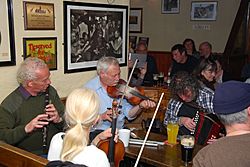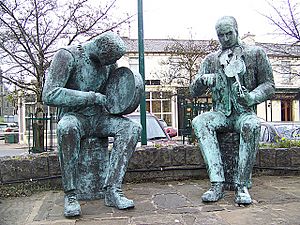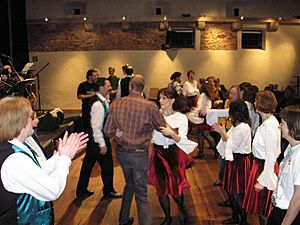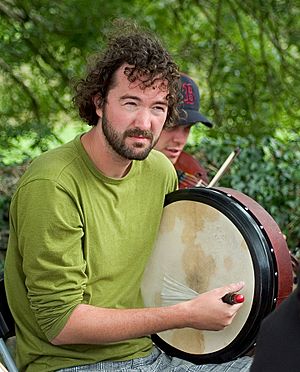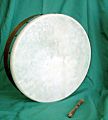Irish traditional music facts for kids
Irish traditional music (also known as Irish trad, Irish folk music, and other variants) is a genre of folk music that developed in Ireland.
There used to be at least ten instruments in general use. These were the cruit (a small harp) and clairseach (a bigger harp with typically 30 strings), the timpan (a small string instrument played with a bow or plectrum), the feadan (a fife), the buinne (an oboe or flute), the guthbuinne (a bassoon-type horn), the bennbuabhal and corn (hornpipes), the cuislenna (bagpipes – see Great Irish warpipes), the stoc and sturgan (clarions or trumpets), and the cnamha (bones). There is also evidence of the fiddle being used in the 8th century.
Though solo performance is preferred in the folk tradition, bands or at least small ensembles have probably been a part of Irish music since at least the mid-19th century, although this is a point of much contention among ethnomusicologists.
Irish traditional music has endured more strongly against the forces of cinema, radio and the mass media than the indigenous folk music of most European countries. This was possibly because the country was not a geographical battleground in either of the two World Wars. Another potential factor was that the economy was largely agricultural, where oral tradition usually thrives.
Historically much old-time music of the USA grew out of the music of Ireland, England and Scotland, as a result of cultural diffusion. By the 1970s Irish traditional music was again influencing music in the US and further afield in Australia and Europe. It has occasionally been fused with rock and roll, punk rock and other genres.
Contents
Musical characteristics
Composition
Irish dance music is isometric and is built around patterns of bar-long melodic phrases akin to call and response. A common pattern is A Phrase, B Phrase, A Phrase, Partial Resolution, A Phrase, B Phrase, A Phrase, Final Resolution, though this is not universal; mazurkas, for example, tend to feature a C Phrase instead of a repeated A Phrase before the Partial and Final Resolutions, for example. Many tunes have pickup notes which lead in to the beginning of the A or B parts. Mazurkas and hornpipes have a swing feel, while other tunes have straight feels.
Tunes are typically binary in form, divided into two (or sometimes more) parts, each with four to eight bars. The parts are referred to as the A-part, B-part, and so on. Each part is played twice, and the entire tune is played three times; AABB, AABB, AABB. Many tunes have similar ending phrases for both A and B parts; it is common for hornpipes to have the second half of each part be identical. Additionally, hornpipes often have three quavers or quarternotes at the end of each part, followed by pickup notes to lead back to the beginning of the A part of onto the B part. Many airs have an AABA form.
While airs are usually played singly, dance tunes are usually played in medleys of 2-4 tunes called sets.
Modes
Irish music generally is modal, using Ionian, Aeolian, Dorian, and Mixolydian modes, as well as hexatonic and pentatonic versions of those scales. Some tunes do feature accidentals.
Ornamentation
Singers and instrumentalists often embellish melodies through ornamentation, using grace notes, rolls, cuts, crans, or slides.
Accompaniment
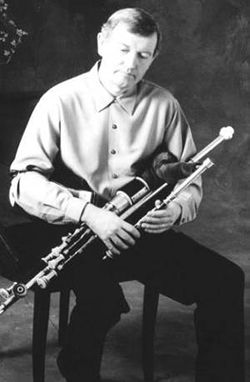
While uilleann pipes may use their drones and chanters to provide harmonic backup, and fiddlers often use double stops in their playing, due to the importance placed on the melody in Irish music, harmony is typically kept simple or absent. Usually, instruments are played in strict unison, always following the leading player. True counterpoint is mostly unknown to traditional music, although a form of improvised "countermelody" is often used in the accompaniments of bouzouki and guitar players. In contrast to many kinds of western folk music, there are no set chord progressions to tunes; many accompanyists use power chords to let the melody define the tonality or use partial chords in combination with ringing drone strings to emphasize the tonal center. Many guitarists use DADGAD tuning because it offers flexibility in using these approaches, as does the GDAD tuning for bouzouki.
Music for singing
Like all traditional music, Irish folk music has changed slowly. Most folk songs are less than 200 years old. One measure of its age is the language used. Modern Irish songs are written in English and Irish. Most of the oldest songs and tunes are rural in origin and come from the older Irish language tradition. Modern songs and tunes often come from cities and towns, Irish songs went from the Irish language to the English language.
Sean-nós songs
Unaccompanied vocals are called sean nós ("in the old style") and are considered the ultimate expression of traditional singing. This is usually performed solo (very occasionally as a duet). Sean-nós singing is highly ornamented and the voice is placed towards the top of the range. A true sean-nós singer, such as Tom Lenihan, will vary the melody of every verse, but not to the point of interfering with the words, which are considered to have as much importance as the melody.
Sean-nós can include non-lexical vocables, called lilting, also referred to by the sounds, such as "diddly die-dely".
Non-sean-nós traditional singing, even when accompaniment is used, uses patterns of ornamentation and melodic freedom derived from sean-nós singing, and, generally, a similar voice placement.
Caoineadh songs
Caoineadh /kˠi:nʲɪ/ is Irish for a lament, a song which is typified by lyrics which stress sorrow and pain. Traditionally, the Caoineadh song contained lyrics in which the singer lamented for Ireland after having been forced to emigrate due to political or financial reasons. The song may also lament the loss of a loved one (particularly a fair woman). Many Caoineadh songs have their roots/basis in The Troubles of Northern Ireland with particular reference to the presence of the British military during this period. Examples of Caoineadh songs include: Far Away in Australia, The Town I Loved So Well, Going Back to Donegal and Four Green Fields.
Caoineadh singers were originally paid to lament for the departed at funerals, according to a number of Irish sources.
Dance music
See also Irish dance.
Social settings
Irish traditional music and dance has seen a variety of settings, from house parties, country dances, ceili dances, stage performances and competitions, weddings, saint's days or other observances. The most common setting for Irish dance music is the seisiun, which very often features no dancing at all.
Repertoire
Traditional dance music includes reels (2
2 or 4
4), hornpipes (4
4 with swung eighth notes), and jigs (double and single jigs are in 6
8 time). Jigs come in various other forms for dancing – the slip jig and hop jig are commonly written in 9
8 time.
Later additions to the repertoire include the waltz (3
4 with a heavy accent on the down beat) and, in Donegal, mazurkas in the same time signature, though with an accent on the 2nd beat. Donegal is also notable for its "highland," a sort of Irish version of the Scottish strathspey, but with a feel closer to a reel with the occasional scots snap.
Polkas are a type of 2
4 tune mostly found in the Sliabh Luachra area, at the border of Cork and Kerry, in the south of Ireland. Another distinctive Munster rhythm is the Slide in 12
8 time.
Style
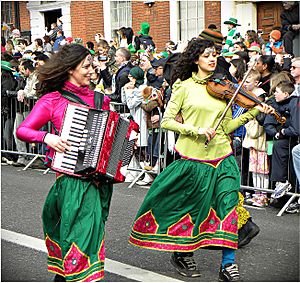
The concept of "style" is of large importance to Irish traditional musicians. At the start of the last century (1900), distinct variation in regional styles of performance existed. With the release of American recordings of Irish traditional musicians (e.g. Michael Coleman 1927) and increased communications and travel opportunities, regional styles have become more standardised. Regional playing styles remain nonetheless, as evidenced by the very different playing styles of musicians from Donegal (e.g. Tommy Peoples), Clare (e.g. brothers John & James Kelly) and Sliabh Luachra (e.g. Jacky Daly). Donegal fiddle playing is characterised by fast, energetic bowing, with the bow generating the majority of the ornamentation; Clare fiddle playing is characterised by slower bowing, with the fingering generating most of the ornamentation. While bowed triplets (three individual notes with the bow reversed between each) are more common in Donegal, fingered triplets and fingered rolls (five individual notes fingered with a single bow stroke) are very common in Clare.
Stage performers from the 1970s and 1980s (groups such as The Bothy Band, or soloists such as Kevin Burke) have used the repertoire of traditional music to create their own groups of tunes, without regard to the conventional 'sets' or the constraint of playing for dancers. Burke's playing is an example of an individual, unique, distinctive style, a hybrid of his classical training, the traditional Sligo fiddle style and various other influences.
Instruments used in traditional Irish music
The most common instruments used in Irish traditional dance music, whose history goes back several hundred years, are the fiddle, tin whistle, flute and Uilleann pipes. Instruments such as button accordion and concertina made their appearances in Irish traditional music late in the 19th century. The 4-string tenor banjo, first used by Irish musicians in the US in the 1920s, is now fully accepted. The guitar was used as far back as the 1930s first appearing on some of the recordings of Michael Coleman and his contemporaries. The bouzouki only entered the traditional Irish music world in the late 1960s.
The word bodhrán, indicating a drum, is first mentioned in a translated English document in the 17th century. The saxophone featured in recordings from the early 20th century most notably in Paddy Killoran's Pride of Erin Orchestra. Céilidh bands of the 1940s often included a drum set and stand-up bass as well as saxophones. Traditional harp-playing died out in the late 18th century, and was revived by the McPeake Family of Belfast, Derek Bell, Mary O'Hara and others in the mid-20th century. Although often encountered, it plays a fringe role in Irish Traditional dance music.
The piano is commonly used for accompaniment. In the early 20th century piano accompaniment was prevalent on the 78rpm records featuring Michael Coleman, James Morrison, John McKenna, PJ Conlon and many more. On many of these recordings the piano accompaniment was woeful because the backers were unfamiliar with Irish music. However, Morrison avoided using the studio piano players and hand-picked his own. The vamping style used by these piano backers has largely remained. There has been a few recent innovators such as Mícheál Ó Súilleabháin, Brian McGrath, Liam Bradley, Josephine Keegan, Ryan Molloy and others.
Celtic rock
Celtic rock is a genre of folk rock and a form of Celtic fusion pioneered in Ireland which incorporates Celtic music, instrumentation and themes into a rock music context. It can be seen as a key foundation of the development of highly successful mainstream Celtic bands and popular musical performers, as well as creating important derivatives through further fusions. Perhaps the most successful product of this scene was the band Thin Lizzy.
Late 20th century: Folk-rock and more
Traditional music, especially sean nós singing, played a major part in Irish popular music later in the century, with Van Morrison, Hothouse Flowers and Sinéad O'Connor using traditional elements in popular songs. Enya achieved enormous international success with New Age/Celtic fusions. The Pogues, led by Shane MacGowan, helped fuse Irish folk with punk rock. This resulted in top ten hits in Ireland, the UK and the USA. Afro-Celt Sound System combined Celtic instrumentals with West African influences and drum n bass in the 1990s.
In the 1980s, major folk bands included De Dannan, Altan, Arcady, Dervish and Patrick Street. A growing interest in Irish music at this time helped many artistes gain more recognition abroad, including Mary Black, and Sharon Shannon. The BBC screened a documentary series about the influence of Irish music called Bringing it all Back Home (a reference to both the Bob Dylan album and the way in which Irish traditional music has travelled, especially in the New World following the Irish diaspora, which in turn has come back to influence modern Irish rock music). This series also helped to raise the profile of many artists relatively little known outside Ireland.
In the 2000s Beoga, Gráda, Danú and Teada are among the youngest major instrumental bands of a largely traditional bent.
There are many other Irish bands developing fusions of local and Irish music such as Flook, Kíla, Gráda and The Dave Munnelly Band.
Images for kids
-
Photograph of Patrick Byrne, harper, by Hill & Adamson (1845), calotype print, 203 × 164 mm, Scottish National Gallery


